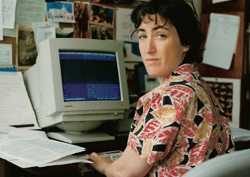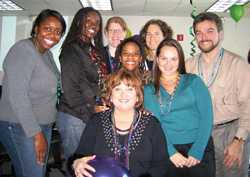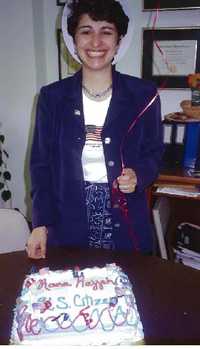Division of Bacterial Diseases (DBD) News Bulletin
This website is archived for historical purposes and is no longer being maintained or updated.
September 30, 2011: Content on this page kept for historical reasons.
In This Issue
- Building 1 History/New Tools
- Building 1 Memories
- Awards
- Vaccine News
- Publications
Spring/Summer 2011
DBD's Memories of Building 1
Matt Moore moved into Building 1 on approximately August 1, 2000. "I moved into what was then the EIS bullpen, room 4414. I had terrific officemates in the 10 or so EIS officers who were then part of the Division of Bacterial and Mycotic Diseases in the National Center for Infectious Diseases. Several of us had California and Oregon connections and so we were major consumers of strong, west coast coffee. We were so committed to good coffee that we joined Peet's "Office Coffee Club". Every month, we looked forward to the 10 pounds of coffee we would receive with free shipping. Our large coffee pot got a good work out, with the first pot around 8am, another around 9am, yet another around 10, and so on. We credit Peet's, in part, with our productivity and our rowdiness, with cries of "Anybody ready for more coffee?!" ringing out over the cubicles."

"In addition to the above, I remember when a certain Branch Chief — who went on to even higher places in CDC — wanted to celebrate the publication of some extremely important recommendations. Branch Chief X tried to smuggle in a bottle of champagne to celebrate, only to be rebuffed by the security personnel who were, post-9/11, doing hand searches of all bags coming in the building. As Branch Chief X was leaving the security screening area, another branch employee was driving to a disabled parking area which fortuitously was not so rigorously screened. Branch Chief X hopped in the car with Employee Y and was whisked to the east entrance of building 1. At our branch meeting later that day, we all enjoyed a few sips of contraband champagne in tiny Dixie paper cups. Never underestimate the creativity of a Building 1 occupant!"
 Anne Schuchat first moved into building 1 in July 1988 to begin EIS in the Division of Bacterial Diseases — in what was then called the Meningitis and Special Pathogens Branch (MSPB). "The group photo (left) is probably from 1991 in Building 1 — I think we were on the 5th floor then before we moved down to the 4th floor in later years. Claire Broome was Chief of MSPB before moving on to heights like CDC's Associate Director for Science and then CDC Deputy Director. Others in the photo included first year EISO Bill Adams, then second year EISOs Brad Perkins and Frank Riedo, Staff epidemiologists (1 yr out from EIS) Bob Pinner and me, as well as staff epidemiologist Jay Wenber (then 2 yrs out from EIS). The other photo (right) taken a couple years later is me in one of my many offices in Building 1, probably was taken around 1995, and for aficionados in DBD I am putting together the ABCs News(letter) — which was a pre-email blast way of keeping the ABCs community at CDC and around the Emerging Infections Program Network sites up on all the latest."
Anne Schuchat first moved into building 1 in July 1988 to begin EIS in the Division of Bacterial Diseases — in what was then called the Meningitis and Special Pathogens Branch (MSPB). "The group photo (left) is probably from 1991 in Building 1 — I think we were on the 5th floor then before we moved down to the 4th floor in later years. Claire Broome was Chief of MSPB before moving on to heights like CDC's Associate Director for Science and then CDC Deputy Director. Others in the photo included first year EISO Bill Adams, then second year EISOs Brad Perkins and Frank Riedo, Staff epidemiologists (1 yr out from EIS) Bob Pinner and me, as well as staff epidemiologist Jay Wenber (then 2 yrs out from EIS). The other photo (right) taken a couple years later is me in one of my many offices in Building 1, probably was taken around 1995, and for aficionados in DBD I am putting together the ABCs News(letter) — which was a pre-email blast way of keeping the ABCs community at CDC and around the Emerging Infections Program Network sites up on all the latest."
 Darcia Johnson was part of a small army of "Get Smart girls" also known as the A-team; who moved to Building 1 under the leadership of the infamous Pat Cook at the end of 2005 (see photo below left in room 3040 of Tanya Hickson, Darcia Johnson, Erica Haller-Stevenson, Jennifer Weissman, Stefanie Anderson, Alison Patti, Jerry Willis and Pat Cook). "We weren't excited about the move. We didn't know how we'd adjust to leaving the "luxury" of our downtown Decatur offices (great parking, restaurants, and Starbucks!), but we did. Not only did we adjust but we came to appreciate the "real" CDC experience of being on the Clifton campus. I was recently at a party and mentioned to another guest where I work and the imminent doom of Building 1 and she became teary eyed. She went on to share with me that her father was a scientist who worked in Building 1 during her youth in the 1960s. She told stories about spending time with her father in this building and the relationships she formed with his colleagues. Meeting that woman was a wonderful reminder that Building 1 is more than just an old building but a historic place."
Darcia Johnson was part of a small army of "Get Smart girls" also known as the A-team; who moved to Building 1 under the leadership of the infamous Pat Cook at the end of 2005 (see photo below left in room 3040 of Tanya Hickson, Darcia Johnson, Erica Haller-Stevenson, Jennifer Weissman, Stefanie Anderson, Alison Patti, Jerry Willis and Pat Cook). "We weren't excited about the move. We didn't know how we'd adjust to leaving the "luxury" of our downtown Decatur offices (great parking, restaurants, and Starbucks!), but we did. Not only did we adjust but we came to appreciate the "real" CDC experience of being on the Clifton campus. I was recently at a party and mentioned to another guest where I work and the imminent doom of Building 1 and she became teary eyed. She went on to share with me that her father was a scientist who worked in Building 1 during her youth in the 1960s. She told stories about spending time with her father in this building and the relationships she formed with his colleagues. Meeting that woman was a wonderful reminder that Building 1 is more than just an old building but a historic place."
 Rana Hajjeh moved to Building 1 in July 1993 as a new EIS officer in the Emerging Bacterial and Mycotic Diseases Branch, which does not exist any longer. "I have a lot of memories in Building 1, especially when working late nights and weekends on outbreak investigations. I also remember vividly all the weekends spent recruiting EIS Officers, when we still had EIS conferences at CDC, and all the good food we brought to keep everybody well fed during these days (I remember my very garlicky Hommos being a big draw for new recruits!). This picture (below right) was taken in May 2000 during a surprise party that my previous team, the Mycotic Diseases Branch, threw for me after I was sworn in as a U.S. citizen. This was a very special day for me; My husband and I had started working on our citizenship papers in 1990 shortly after my daughter was born, and the process had taken ten long years!"
Rana Hajjeh moved to Building 1 in July 1993 as a new EIS officer in the Emerging Bacterial and Mycotic Diseases Branch, which does not exist any longer. "I have a lot of memories in Building 1, especially when working late nights and weekends on outbreak investigations. I also remember vividly all the weekends spent recruiting EIS Officers, when we still had EIS conferences at CDC, and all the good food we brought to keep everybody well fed during these days (I remember my very garlicky Hommos being a big draw for new recruits!). This picture (below right) was taken in May 2000 during a surprise party that my previous team, the Mycotic Diseases Branch, threw for me after I was sworn in as a U.S. citizen. This was a very special day for me; My husband and I had started working on our citizenship papers in 1990 shortly after my daughter was born, and the process had taken ten long years!"
Conrad Quinn and his team have had success, despite sub-optimal conditions. "The mission of the anthrax vaccine clinical trial was miraculously accomplished while working in decrepit building 1 laboratories; proof that DBD laboratorians can overcome adversity and rise to the occasion."
Brian Plikaytis moved into Building 1 May, 1977 and spent pretty much his entire career on floors 4 and 5. "I joined the Bacterial Diseases Division in the Bureau of Epidemiology. Branches were Meningitis and Special Pathogens, Enteric Diseases, Bacterial Zoonoses, and Hospital Infections."
"In those days there was no security. Anyone who had a mind to could enter the building and walk around freely. We were told reporters would walk in and see if they could find anything interesting laying on top of people's desks and that we were supposed to lock stuff away when we were away from our desks to prevent this. The lab areas really didn't have any better security but they would recognize a stranger and ask them what their business was. In the office areas, we were used to seeing strangers as the office folk would walk from floor to floor as they conducted their business."
"In the pre-network days, we had Wang word processors. They were independent architectures where each Division would have a CPU (about the size of a dishwasher) and double cables strung to each work station. Disk drives used 8-inch floppy disks and they were also large and centrally located. I was working one Saturday and had to walk down to the Director's office to load a floppy to pull down a file. As I walked in the door, I met a well-dressed guy on the way out with a large shopping bag. He was wearing a white shirt, tie and slacks. He dropped the bag, pardoned himself and left. I really didn't think anything about it until the next Monday. I was late getting in and people in the Director's office were all milling around trying to figure out what the deal was with the bag. I told them what I saw. Apparently, the guy was going through the offices and stealing whatever he thought would be valuable. I spooked him when I walked in, he dropped the bag and left."
"Speaking of computers, we had one, an IBM mainframe, and it was located in the room now occupied by the EOC in SSB of Building 1-East. We were just moving from submitting jobs using 80-column IBM punched cards to using dumb terminals located throughout the building. There were a couple of key-punch machines available to those who still used card decks and they had a card sorter in the input/output lobby by the mainframe where you could put in data cards and sort them. After sorting, you would count the ones that fell in specific slots and this is how some people would create their frequency tables back then. If anyone has seen an old detective show like Dragnet or the like, you would know what the card sorter looked like. The only printers were located by the computer as they were huge and expensive. So imagine submitting an analysis job, waiting in line for it to be executed (could take minutes, could take hours depending on how busy things were), you would review the results, fix any errors, resubmit the job and wait some more. We were sometimes lucky to get an hour's worth of work by today's standards done in 8 hours back then. When the job was completed, you would print the results and run down to the computer room to pick up the output."
"When I first came here, you could walk through the bowels of the building where the steam pipes were located. These areas were designated as evacuation locations in case of storms, nuclear wars, or whatever. There were actually barrels of supplies (food and other stuff) stacked against the walls with dates that reached back to WWII."
Top of Page- Page last reviewed: September 30, 2011 (archived document)
- Content source:


 ShareCompartir
ShareCompartir